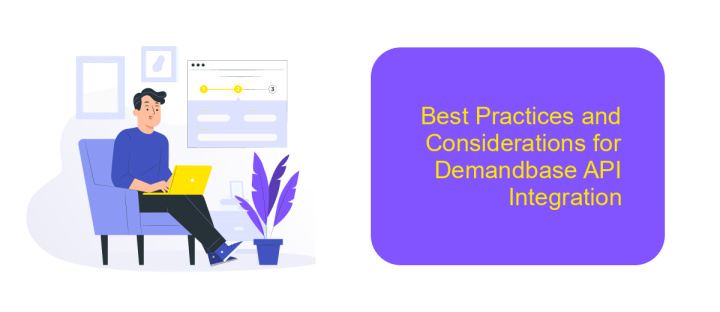Demandbase API Integration
Integrating the Demandbase API into your business processes can significantly enhance your marketing and sales strategies. This powerful tool provides access to comprehensive account-based marketing data, enabling personalized targeting and improved customer engagement. By leveraging Demandbase's robust API, businesses can streamline their operations, optimize lead generation, and gain valuable insights into customer behavior, ultimately driving growth and maximizing ROI. Discover how this integration can transform your approach to data-driven decision-making.
Introduction to Demandbase and its API
Demandbase is a leading B2B marketing platform that empowers businesses to identify, engage, and nurture their target accounts. By leveraging artificial intelligence and big data, Demandbase provides deep insights and analytics, enabling marketers to create highly personalized and effective campaigns. This platform is particularly valuable for organizations looking to enhance their account-based marketing (ABM) strategies, as it offers tools for precise targeting and performance measurement.
- Comprehensive account identification and targeting capabilities.
- Advanced analytics and reporting for data-driven decision making.
- Seamless integration with existing marketing and sales tools.
- AI-powered insights for personalized customer engagement.
- Robust API for custom integrations and workflow automation.
The Demandbase API extends the platform's capabilities by allowing developers to integrate its powerful features into their own applications and systems. This API provides access to a wide range of functionalities, from retrieving account data to managing user interactions. By using the Demandbase API, businesses can automate processes, enhance their marketing efforts, and gain a competitive edge in the B2B landscape. Its flexibility and comprehensive documentation make it an essential tool for any organization aiming to optimize its marketing strategies.
Understanding the Demandbase API Functionality

The Demandbase API offers a robust suite of functionalities that enable businesses to harness the power of account-based marketing (ABM) with precision and efficiency. By providing access to real-time data and insights, the API allows organizations to enhance their marketing strategies, targeting specific accounts with personalized content. This level of customization is crucial for businesses aiming to optimize their engagement and conversion rates. The API's capabilities extend to data enrichment, account identification, and engagement tracking, making it an essential tool for businesses looking to leverage data-driven marketing tactics.
Integrating the Demandbase API into existing systems can be streamlined using services like ApiX-Drive, which simplifies the connection between various applications and the API. ApiX-Drive offers a user-friendly interface that allows for seamless integration without the need for extensive coding knowledge. This service not only accelerates the setup process but also ensures that data flows smoothly between platforms, maximizing the efficiency of marketing operations. By utilizing such integration services, businesses can focus on leveraging the Demandbase API's functionalities to drive growth and achieve their marketing objectives.
Implementing the Demandbase API Integration

Integrating the Demandbase API into your system can significantly enhance your marketing and sales strategies by providing rich insights and data-driven decisions. To begin, ensure you have a Demandbase account and access to API credentials. This integration allows you to leverage Demandbase's powerful data analytics and targeting capabilities, optimizing your outreach efforts.
- First, acquire your API key from the Demandbase dashboard. This key is essential for authenticating your requests.
- Next, familiarize yourself with the API documentation. Understanding the available endpoints and data structures is crucial for seamless integration.
- Proceed by setting up a secure connection to the API using your preferred programming language. Ensure that your environment can handle HTTP requests and responses.
- Implement error handling to manage potential issues such as rate limits or invalid requests, ensuring a robust integration.
- Finally, test the integration thoroughly in a development environment before deploying it to production.
By following these steps, you can effectively implement the Demandbase API, unlocking valuable insights and enhancing your business strategies. Regularly update your integration to align with any changes in the API and maintain optimal performance. This proactive approach ensures that your team remains ahead in the competitive landscape.
Best Practices and Considerations for Demandbase API Integration

Integrating Demandbase API into your systems can significantly enhance your marketing and sales strategies by providing enriched data and insights. However, to ensure a smooth and efficient integration, it's crucial to follow best practices and consider key factors during the process.
Firstly, thoroughly understand the API documentation provided by Demandbase. This will help you grasp the capabilities and limitations of the API, ensuring you make informed decisions. Additionally, maintain clear communication with your internal teams and Demandbase support to address any technical challenges promptly.
- Ensure your systems are compatible with Demandbase API requirements.
- Implement robust error handling to manage API request failures gracefully.
- Regularly update your integration to align with API changes and enhancements.
- Monitor API usage to optimize performance and avoid exceeding rate limits.
Lastly, prioritize data security and privacy by adhering to compliance standards and implementing necessary safeguards. By following these best practices and considerations, you can maximize the value of Demandbase API integration and drive better business outcomes.
- Automate the work of an online store or landing
- Empower through integration
- Don't spend money on programmers and integrators
- Save time by automating routine tasks
Troubleshooting and Common Issues
When integrating the Demandbase API, one common issue is authentication errors. These often arise due to incorrect API keys or outdated tokens. Ensure that your API keys are correctly configured and up-to-date. Double-check the permissions associated with your API keys, as insufficient permissions can lead to access issues. If you're using a service like ApiX-Drive for integration, verify that the connection settings are properly configured, and that the Demandbase API endpoints are correctly specified in the setup.
Another frequent challenge is data synchronization discrepancies. This can occur if there are mismatches in data formats or unexpected changes in the Demandbase API schema. Regularly review the API documentation for any updates or changes. Use logging and monitoring tools to track data flow and identify any inconsistencies. If you're leveraging ApiX-Drive, take advantage of its troubleshooting tools to diagnose and resolve synchronization issues efficiently. Always test your integration in a controlled environment before deploying it to ensure smooth operation.
FAQ
What is Demandbase API Integration used for?
How can I integrate Demandbase API into my existing systems?
What are the prerequisites for using Demandbase API?
Can I automate data synchronization between Demandbase and my CRM?
What are the common challenges faced during Demandbase API Integration?
Time is the most valuable resource in today's business realities. By eliminating the routine from work processes, you will get more opportunities to implement the most daring plans and ideas. Choose – you can continue to waste time, money and nerves on inefficient solutions, or you can use ApiX-Drive, automating work processes and achieving results with minimal investment of money, effort and human resources.


